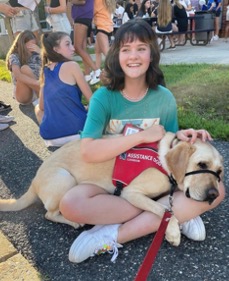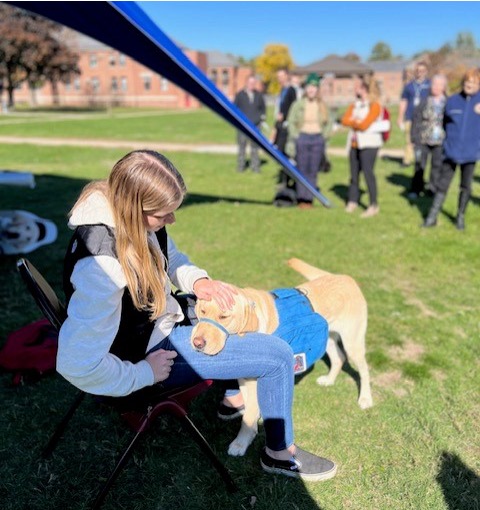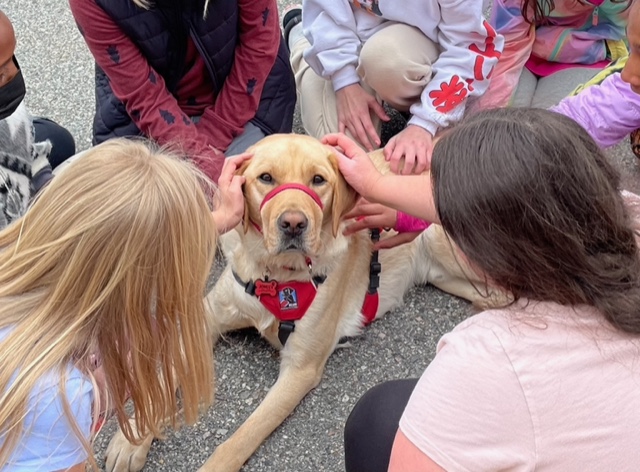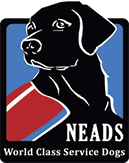The Different Personalities of NEADS Dogs
January 25, 2024
by NEADS Apprentice Trainer Leah Bell
Why having different personalities and temperaments in our dogs is important.
NEADS dogs can follow several different career paths. Service Dogs are matched with people with physical disabilities, hearing loss, veterans with PTSD, and children with autism or other developmental disabilities. These dogs have public access rights according to the Americans with Disabilities Act (ADA). Assistance Dogs work with classroom, ministry, courthouse, counseling, and hospital professionals. These dogs do not have public access under the ADA.
Whether the dog follows the Service Dog or Assistance Dog path, it will go through about two years of training. It will get socialized to the world, learn the same obedience commands, and learn how to properly behave and perform commands in public.
Differences between Service Dogs and Assistance Dogs
So now let’s look at some of the differences between Service Dogs and Assistance Dogs:
- A Service Dog works with one person, while an Assistance Dog, together with its human partner, works with many people.
- A Service Dog has full public access, meaning it can go where its human partner goes. An Assistance Dog, on the other hand, typically has access by invitation. For example, let’s say I’m a special education teacher and I have an Assistance Dog. I cannot take my Assistance Dog with me while I shop in the grocery store, but my Assistance Dog can join me at school because I am working, and my Assistance Dog is part of my work.
- A Service Dog has been taught task work specific to the needs of its human partner, and an Assistance Dog has been taught task work specialized to its working environment.
- A Service Dog works with one person over a long period of time, and an Assistance Dog interacts with many people during short sessions.
What is not different is that no matter what program the dog is part of, both the dog and the NEADS client have ongoing support from NEADS trainers and staff for the life of the dog.
Taskwork varies by program.
 While the dogs may learn the same tasks, their uses can vary depending on the program. Here are just a few examples:
While the dogs may learn the same tasks, their uses can vary depending on the program. Here are just a few examples:
- My Lap: A client with a Service Dog can ask their dog to retrieve an item, have the dog to My Lap, the dog will put the front paws on the person’s side and let go of the item when asked. Ask an Assistance Dog to do My Lap, and the dog will lay their body across the person’s thighs of someone who is lying down, which provides deep pressure therapy.
- Visit: A task where the dog rests their head and provides pressure to a person’s body. For both Service and Assistance Dogs, this is a form of tactile pressure. Visit can be paired with a breathing exercise to calm and relieve stress and anxiety.
- Fetch: A task that tell the dog to pick something up. A client can name an item and the dog will pick up that specific item, for example, Fetch Leash. Our Assistance Dogs know Fetch the Tissues, which is used as a way to engage someone who is upset by having the dog offer them a tissue box.
- Nudge: Our Service Dogs learn Nudge Light, and the dog will turn on specific light switch. Our Assistance Dogs can turn the page of a board book using their nose with the cue Nudge Page. This is used to build individual reading skills and confidence or encourage group participation in reading circles.
- Tell Me a Secret: A task only the Assistance Dogs learn. This is used to engage a person or child. For example, NEADS client Samantha, a forensic interviewer tells her Assistance Dog Chief, “tell me a secret.” He approaches her slowly and nuzzles her ear. This shows the child that if Chief can tell the interviewer a secret and be safe, so can the child.
How does NEADS choose a career for a dog?
The dogs tell us.
The trainers look at what the dog is good at and, most importantly, what the dog likes to do. In order for the dogs and clients to be successful, we make sure the dog is both happy to work and is good at their job. It’s like with people – some people are really good with their hands, so they might make a really good plumber or a good roofer. Some people are really good with numbers and data so there might be a really good math teacher or engineer. All jobs are needed, and one isn’t better than the other. They’re just different. It’s the same with our dogs.

The power of our dogs
I’m sure everyone reading this knows how special dogs are and the impact they have by just being there. Each NEADS dog is powerful and impactful in its own way, whether a Service Dog or Assistance Dog. All our dogs do incredible things, from alerting their person to the smoke detector to being a place of support and love for someone during a hard therapy session.

